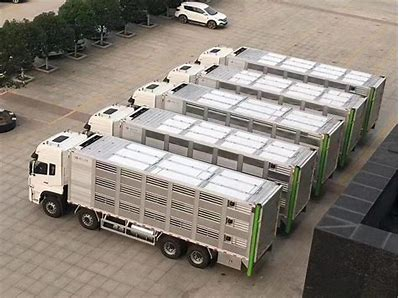
Release Date:2024.09.26
The stress response of pigs during long-distance transportation can lead to multiple adverse outcomes, including disease transmission, injury, reduced productivity, and impaired well-being. Therefore, it is very important to carry out scientific research on long-distance transportation of pigs and formulate preventive measures for stress response. At the Leman China Swine Conference, experts provided policy advice on long-distance transport of pigs to ensure the sustainable development of the breeding industry.
1 Stress response of pigs during long-distance transportation
1.1 Stress factors during transportation
Stress factors in long-distance transport of pigs are multifaceted and include environmental, social, physiological, and behavioral factors. Pigs usually live in a relatively closed enclosure, and long-distance transport takes them from this familiar environment to a completely new place. This change in environment can itself lead to a stress response; Secondly, crowding and congestion in the process of transportation is also an important stress factor; Third, the road conditions for long-distance transport and the vibration of transport vehicles can also cause stress in pigs. In addition, the fluctuation of temperature is also one of the stress factors. If the staff acts in an inappropriate way to handle the pigs, such as rough shoving, using electric batons or other violent means, the pigs may feel scared, in pain and angry, further aggravating the stress.
1.2 Physiological and behavioral manifestations of stress response
From the physiological aspect, stress may lead to changes in physiological indicators of pigs. Prolonged transport and environmental discomfort can cause pigs to become dehydrated and short of breath. These physiological responses not only increase the physical burden of pigs, but may also lead to malnutrition and suppression of the immune system, which increases the risk of infection and disease. On the behavioral side, the stress response may manifest itself in a variety of different behaviors. Pigs may become agitated and constantly look for exits or escape from the transport container. They may also exhibit aggressive behaviour, which may lead to injury between pigs and may also increase their risk in transport, as pigs under stress may be more prone to injury or accidents.

2 Before long distance transportation of pigs
There are several key steps before preparing pigs for transport. First of all, it is necessary to choose the appropriate time, usually in mid-May or late September each year, because the temperature is moderate at this time, suitable for long-distance pig transportation; Secondly, the appropriate transport vehicle should be selected to ensure that the vehicle has been maintained before departure, is in good condition, and the bottom of the carriage is moderate to accommodate the cage of the pigs. In addition, 2 healthy drivers and 1 escort with experience in pig farm should be equipped. Feed for pigs should be stopped before loading to reduce the risk of vomiting and anal prolapse. In addition, each pig should be injected with long-acting antibiotics or anti-stress drugs at loading time to reduce the possibility of stress and infection. Finally, vehicles and appliances need to be thoroughly disinfected before loading the pigs.
3 Pigs in long-distance transportation
Ensure that the vehicle takes informed route decisions after departure, as this choice is critical and requires careful planning.
Pigs are prone to stress reactions during long-distance transportation, so a range of measures are needed to prevent and manage stress. To alleviate the stress of transport on pigs, the addition of ingredients such as electrolytic multidimensional and rehydration salts to the feed can be considered and ensure that the feed provided is easy to be absorbed by the GI tract. The fence door must be checked frequently for firmness throughout the transportation process to prevent unexpected events such as pig escape. If a pig dies during transportation, the carcass should not be discarded at will, but should be immediately isolated and sterilized. This meticulous series of measures helps to ensure the well-being and safety of pigs during long-distance transport.

4 Pigs after long-distance transportation
Once the transport vehicle arrives at its destination, a suitable unloading location should be selected immediately to minimize the time required for unloading. However, care must be taken during unloading to avoid rough handling of the pigs. Before transporting pigs to their destination, quarantine facilities should be prepared in advance to ensure proper isolation and breeding of pigs. Pigs must be properly grouped according to their weight and health status to manage them more effectively before being housed in isolation. Once the car is unloaded, it should not be fed immediately, but should provide water for the pig to drink as soon as possible, and then feed the thinning material in the right amount after 1 ~ 2 h.
5 Conclusion
Long-distance transport of pigs is essential for the agricultural sector, but stress reactions can negatively impact the health and well-being of pigs, so a range of measures are needed to ensure the safety and success of long-distance transport of pigs. Pre-transport preparation involves choosing the right time, vehicle and personnel to ensure that pigs are in optimal condition before transport. After long-distance transportation, isolation and proper management are essential for the recovery of pigs, including feeding, disinfection, and timely medical attention. Through these measures, it is possible to reduce the risk of stress in pigs during long-distance transportation and reduce the possibility of injury, disease transmission and death. At the same time, this will also help improve the production efficiency of the breeding industry, ensure sustainable agricultural development, and maintain the well-being of pigs.
If you would like to learn more about the pig industry, please visit the Leman China Swine Conference website for more information.
Source:SWINE INDUSTRY SCIENCE
If there is any infringement, please contact to delete.